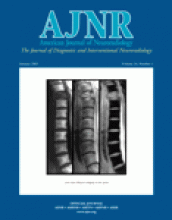In recent years, the use of newer and combined techniques for the evaluation of brain activity during wakefulness and sleep has added new perspectives to our understanding of these different states. Among currently useful ways of determining regional brain activity are the electrophysiologic monitoring of wakefulness and sleep by using the techniques of electroencephalography (EEG), polysomnography (PSG), and functional MR imaging (fMRI). Ample evidence establishes distinct physiologic differences between the waking and sleeping states and also between the stages of non–rapid eye movement (NREM) sleep and rapid eye movement (REM) sleep. Brain activity during REM sleep was previously found to be important in mood disorders, memory, and learning. Combined studies have more recently identified clear evidence for the processing of auditory information and language during NREM sleep.
A case report in this issue of the AJNR presents the possibility of assessing the localization of language processing with the coincidence of sleep and fMRI during an evaluation for surgery. Because sleeping occurred by chance in the child reported, the assessment of sleep was conducted by means of behavioral observation. In this instance, we cannot be certain what stage of sleep was actually occurring, but NREM sleep would seem more likely than REM sleep under the circumstances. At present, natural sleep (as in this instance), rather than sedated sleep, appears to be best for assessing functional localization. The authors correctly point out that sedative medication may confound the results.
The advantage of testing while the patient is asleep is potentially limited, for a number of reasons. The need to obtain a baseline fMRI study for comparison followed by auditory input in the form of stories and further imaging poses some logistical concerns. Such needs may render the timing of sleep and imaging unpredictable. Unfortunately, the choice of sleep deprivation before the test may also increase the likelihood of clinical seizures. Young children may not necessarily be able to reliably fall asleep during such studies in the daytime hours, even when sleep deprived. The potential advantage of a motion-free study during sleep may be offset by such uncertainties, particularly in young children. Nevertheless, in the current report, the observation that corresponding language areas are prominent during sleep is noteworthy. At this point, spontaneous sleep, if it happens to occur during testing, may appear to be helpful because of some of the reasons indicated. However, not all sleep stages are equivalent, and confusion could potentially occur if different sleep stages are encountered. Physiologic responses in NREM sleep stages 3–4 and in REM sleep may be considerably different from those in the more commonly observed NREM sleep stages 1 and 2 that typically occur at sleep onset. Further delineation of fMRI findings in wakefulness and in sleeping may also help to satisfy those who believe in a continuing need to more firmly establish the accuracy of such noninvasive testing as a feasible alternative to older intracarotid amobarbital testing.
The present report also adds to the information that is being accumulated on the blood oxygenation level–dependent (BOLD) contrast responses. Increasing evidence indicates that the authors’ suggestion that language processing during spontaneous natural sleep can be detected in young children by using an fMRI technique will likely be proven valid. Until functional similarities and differences of brain activity during waking and various sleep stages are better established, the importance of individual observations leaves some uncertainty. Newer vistas continue to open in our understanding of brain function. An increasingly elaborate landscape seems to be emerging in which the organization of brain functions may vary substantially and even fundamentally, depending on whether the brain is awake or asleep in the conventional sense. If asleep, however, the organization of brain functions may also be very different, depending on the stage of sleep occurring at the time. For the alert investigator, fMRI can help to open some of these vistas and to improve our understanding of these processes.
- Copyright © American Society of Neuroradiology












